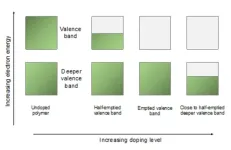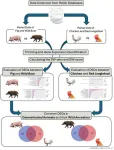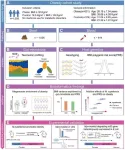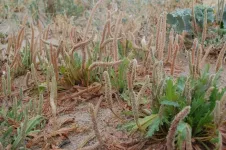(Press-News.org)
Cavendish physicists have discovered two new ways to improve organic semiconductors. They found a way to remove more electrons from the material than previously possible and used unexpected properties in an environment known as the non-equilibrium state, boosting its performance for use in electronic devices.
“We really wanted to hit the nail and figure out what is happening when you heavily dope polymer semiconductors,’ said Dr Dionisius Tjhe, Postdoctoral Research Associate at the Cavendish Laboratory. Doping is the process of removing or adding electrons into a semiconductor, increasing its ability to carry electrical current.
In a recent paper published in Nature Materials, Tjhe and his colleagues detail how these novel insights could be helpful in improving the performance of doped semiconductors.
Energy bands at unprecedented levels of doping
Electrons in solids are organised into energy bands. The highest-energy band, referred to as the valence band, controls many of the important physical properties such as electrical conductivity and chemical bonding. Doping in organic semiconductors is achieved by removing a small fraction of electrons from the valence band. Holes, the absence of electrons, can then flow and conduct electricity.
“Traditionally, only ten to twenty percent of the electrons in an organic semiconductor’s valence band are removed, which is already much higher than the parts per million levels typical in silicon semiconductors,” said Tjhe. “In two of the polymers that we studied, we were able to completely empty the valence band. More surprisingly, in one of these materials we can go even further and remove electrons from the band below. This could be the first time that’s been achieved!”
Interestingly the conductivity is significantly larger in the deeper valence band, compared to the top one. “The hope is that charge transport in deep energy levels could ultimately lead to higher-power, thermoelectric devices. These convert heat into electricity,” said Dr Xinglong Ren, Postdoctoral Research Associate at the Cavendish Laboratory and co-first author of the study. “By finding materials with a higher power output, we can convert more of our waste heat into electricity and make it a more viable energy source.”
Why was this observed in this material?
Although the researchers believe that the emptying of the valence band should be possible in other materials, this effect is perhaps most easily seen in polymers. “We think that the way the energy bands are arranged in our polymer, as well as the disordered nature of the polymer chains allows us to do this,” said Tjhe. “In contrast, other semiconductors, such as silicon, are probably less likely to host these effects, as it is more difficult to empty the valence band in these materials. Understanding how to reproduce this result in other materials is the crucial next step. It’s an exciting time for us.”
Is there another way to increase the thermoelectric performance?
Doping leads to an increase in the number of holes, but it also increases the number of ions, which limits the power. Luckily, researchers can control the number of holes, without affecting the number of ions, by using an electrode known as a field-effect gate.
“Using the field-effect gate, we found that we could adjust the hole density, and this led to very different results,” explained Dr Ian Jacobs, Royal Society University Research Fellow at the Cavendish Laboratory. “Conductivity is normally proportional to the number of holes, increasing when the number of holes are increased, and decreasing when they are removed. This is observed when we change the number of holes by adding or removing ions. However, when using the field-effect gate, we see a different effect. Adding or removing holes always causes a conductivity increase!”
Harnessing the power of the non-equilibrium state
The researchers were able to trace these unexpected effects to a ‘Coulomb gap’, a well-known, though rarely observed feature in disordered semiconductors. Interestingly, this effect disappears at room temperature and the expected trend is recovered.
“Coulomb gaps are notoriously hard to observe in electrical measurements, because they only become visible when the material is unable to find its most stable configuration,” Jacobs added. “On the other hand, we were able to see these effects at much higher temperatures than anticipated, only about -30°C.”
“It turns out that in our material, the ions freeze; this can happen at relatively high temperatures,” said Ren. “If we add or remove electrons when the ions are frozen, the material is in a non-equilibrium state. The ions would prefer to rearrange and stabilise the system, but they can’t because they are frozen. This allows us to see the Coulomb gap.”
Usually there is a tradeoff between thermoelectric power output and conductivity, one increases whilst the other decreases. However, due to the Coulomb gap and the non-equilibrium effects, both can be increased together, meaning the performance can be improved. The only limitation is that the field-effect gate currently only affects the surface of the material. If the bulk of the material can be affected, it would increase the power and conductivity to even larger magnitudes.
Though the group still has some headway to make, the research paper outlines a clear method to improve the performance of organic semiconductors. With exciting prospects in the energy field, the group have left the door open for further investigation of these properties. “Transport in these non-equilibrium states has once again proved to be a promising route for better organic thermoelectric devices,” said Tjhe.
END
Housing policies may be becoming more pet inclusive, but housing insecurity is getting worse, finds a new study that examined the housing issues that led to owners turning their pets over to an animal shelter.
“Over the duration of the study, instances of animals entering shelters due to loss of housing rose, while those due to pet restrictions and landlord conflicts declined,” said the study’s lead author Jennifer Applebaum, Ph.D., an assistant professor in the Department of Environmental and Global Health in the University ...
Eye-tracking allows studying aspects that cannot be seen, for example, the thinking processes of a student solving a mathematical problem. Researchers at Kaunas University of Technology (KTU) are the first in Lithuania to integrate eye-tracking into education and are using the technology to radically improve the teaching of mathematics.
Eye-tracking creates the possibility for researchers to observe a subject’s attention shifts based on where they fix their gaze or how they move it. This helps researchers understand various emotional, thinking and cognitive processes that happen in response to the environment.
“By applying this technology in mathematical education, ...
□ Overview
○ Event: The 37th International Geological Congress 2024 (IGC 2024)
○ Date/Venue:: 25 Aug (Sun) - 31 Aug (Sat) 2024, 7 days / BEXCO, Busan, Republic of Korea ※ Hosted in a 4-year cycle across continents
○ Scale: Over 7,000 participants from 121 countries (more than 3,000 scientipic programs, 250 exhibition booths)
○ Theme: The Great Travelers: Voyages to the Unifying Earth
○ Host: International Union of Geologcial Sciences (IUGS)
○ Organizer: IGC 2024 Organizing Committee (The Geological Society Of Korea, Korea Institute of Geoscience and Mineral Resources, Busan Metropolitan ...
Wild boars and red junglefowl gave rise to common pigs and chickens. These animals’ genes evolved to express themselves differently, leading to signatures of domestication — such as weaker bones and better viral resistance — in pigs and chickens, according to a research team based in Japan.
The findings, published on July 6 in Animals, could provide insight into the genetic changes of the domestication process and highlight target genes for healthier and more productive livestock breeding, the researchers ...
A recent study published in Cell Host & Microbe identifies a potential obesity-linked bacterium, Megamonas, from a large-scale cohort of obese individuals in China. This research suggests potential strategies for future obesity management by illustrating how the bacterium degrades intestinal myo-inositol, enhances lipid absorption, and contributes to obesity.
The study is jointly conducted by Ruijin Hospital affiliated with Shanghai Jiao Tong University School of Medicine, BGI Research, and BGI Genomics Institute of Intelligent Medical Research (IIMR).
"Through a large-scale study of intestinal ...
Ozone can be an agent of good or harm, depending on where you find it in the atmosphere. Way up in the stratosphere, the colorless gas shields the Earth from the sun’s harsh ultraviolet rays. But closer to the ground, ozone is a harmful air pollutant that can trigger chronic health problems including chest pain, difficulty breathing, and impaired lung function.
And somewhere in between, in the upper troposphere — the layer of the atmosphere just below the stratosphere, where most aircraft cruise — ozone contributes to warming the planet as a potent greenhouse gas.
There are signs that ozone is continuing to rise in the upper troposphere despite efforts to reduce its ...
A new pathway that is used by cancer cells to infiltrate the brain has been discovered by a team of Canadian and American research groups led by the Singh Lab at McMaster University. The research also reveals a new therapy that shows promise in blocking and killing these tumors.
The research, published in Nature Medicine on Aug. 2, 2024, offers new hope and potential treatments for glioblastoma, the most aggressive form of brain cancer. With existing treatments like surgery, radiation therapy and chemotherapy, the tumors often return, and
patient survival is limited to only a few months. With this new treatment, ...
Scientists have developed a new, safe and effective way to infect volunteers with the parasite that causes leishmaniasis and measure the body’s immune response, bringing a vaccine for the neglected tropical disease a step closer.
The breakthrough, by a team from the University of York and Hull York Medical School, is described in the journal Nature Medicine and lays the foundations for vaccine development and for testing new preventative measures.
Controlled human infection studies, where volunteers are exposed to small amounts of ...
Two of the planet’s more pressing environmental stressors have the potential to alter the growth and reproductive output of plants found right along the world’s coastlines, a new study suggests.
The research, published in the journal Environmental Pollution, is one of the first to examine the combined effects of seawater flooding and microplastic pollution on coastal plants.
It showed that both stressors had some effects on the species tested, with microplastics impacting the plants’ reproduction while flooding caused greater tissue death.
However, being exposed to both microplastics ...
A newly developed timeline of early animal fossils reveals a link between sea levels, changes in marine oxygen, and the appearance of the earliest ancestors of present-day animals.
The study reveals clues into the forces that drove the evolution of the earliest organisms, from which all major animal groups descended.
A team from the University of Edinburgh studied a compilation of rocks and fossils from the so-called Ediacaran-Cambrian interval – a slice of time 580–510 million years ago. This period witnessed an explosion of biodiversity according to fossil records, the causes of which have ...







